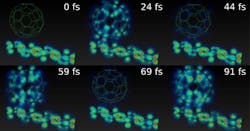European physicists create simulation (note: it's visually quite interesting) and measure coherent oscillations in organic solar-cell material

A team of physicists from a number of universities and institutes in Germany, Italy, France, and Spain has experimentally confirmed a coherent oscillation of light received in a particular type of organic photovoltaic cell containing fullerenes (carbon-based "buckyballs") and conjugated polymers.1
Using high-resolution temporal spectroscopy, the European team has confirmed that the energy oscillates coherently between the fullerene and the polymer, measuring a 25-fs period (the coherent period) rather than a longer 100-fs period corresponding to incoherent transfer.
Homebuilt spectrometer
The researchers constructed their own ultrabroadband pump-probe spectrometer with a resolution of better than 15 fs; built around a regeneratively amplified mode-locked Ti:sapphire laser producing 150-fs pulses at a 1 kHz repetition rate, the system drives two independent non-collinear optical parametric amplifiers (NOPAs), one producing sub-10-fs pump pulses at a 540 nm wavelength, and the other producing 15-fs probe pulses in the near-IR that are frequency-doubled to 460 nm.
A series of sophisticated quantum-dynamics simulations created by the researchers provides impressive movies of the evolution of the electronic cloud and of the atomic nuclei in this system, which are responsible for the oscillations found in the experiments. "Our calculations indicate that the coupling between electrons and nuclei is of crucial importance for the charge transfer efficiency," says Elisa Molinari of the Istituto Nanoscienze of CNR and the University of Modena and Reggio Emili, who, along with Carlo A. Rozzi, Istituto Nanoscienze CNR, created the simulations. "Tailoring this coupling by varying the device morphology and composition hence may be important for optimizing device efficiency."
Will the new results immediately lead to better solar cells? "Such ultrafast spectroscopic studies, and in particular their comparison with advanced theoretical modelling, provide impressive and most direct insight in the fundamental phenomena that initiate the organic photovoltaic process. They turn out to be very similar to the strategies developed by nature in photosynthesis," says Christoph Lienau, a physics professor from the University of Oldenburg who led the research team. "Recent studies indicate that quantum coherence apparently plays an important role in that case. Our new results provide evidence for similar phenomena in functional artificial photovoltaic devices: a conceptual advancement which could be used to guide the design of future artificial light-harvesting systems in an attempt to match the yet unrivaled efficiency of natural ones."
The team included members from Carl von Ossietzky Universität (Oldenburg, Germany), Istituto Nanoscienze–Consiglio Nazionale delle Ricerche (CNR; Modena, Italy), Istituto di Fotonica e Nanotecnologie–CNR (Milano, Italy), University of Konstanz (Konstanz, Germany), CNRS, Universitè Paris-Sud (Orsay, France), UPV/EHU-University of the Basque Country (San Sebastián, Spain), Fritz-Haber-Institut der Max-Planck-Gesellschaft (Berlin, Germany), and Università di Modena e Reggio Emilia (Modena, Italy).
Sources: http://www.alphagalileo.org/ViewItem.aspx?ItemId=142345&CultureCode=en and http://www.eurekalert.org/pub_releases/2014-05/in-c-frt053014.php
REFERENCE:
1. S. Maria Falke et al., Science, 30 May 2014; DOI: 10.1126/science.1249771
About the Author
John Wallace
Senior Technical Editor (1998-2022)
John Wallace was with Laser Focus World for nearly 25 years, retiring in late June 2022. He obtained a bachelor's degree in mechanical engineering and physics at Rutgers University and a master's in optical engineering at the University of Rochester. Before becoming an editor, John worked as an engineer at RCA, Exxon, Eastman Kodak, and GCA Corporation.
